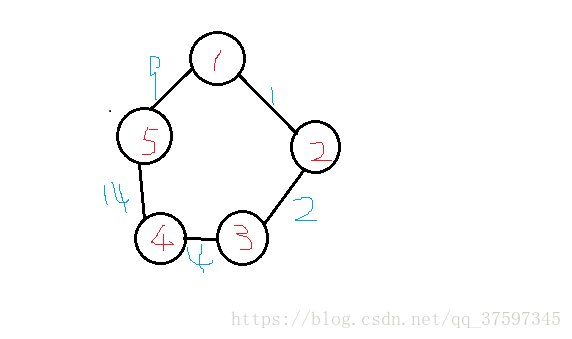The task is really simple: given N exits on a highway which forms a simple cycle, you are supposed to tell the shortest distance between any pair of exits.
Input Specification:
Each input file contains one test case. For each case, the first line contains an integer N (in [3, 10^5^]), followed by N integer distances D~1~ D~2~ ... D~N~, where D~i~ is the distance between the i-th and the (i+1)-st exits, and D~N~ is between the N-th and the 1st exits. All the numbers in a line are separated by a space. The second line gives a positive integer M (<=10^4^), with M lines follow, each contains a pair of exit numbers, provided that the exits are numbered from 1 to N. It is guaranteed that the total round trip distance is no more than 10^7^.
Output Specification:
For each test case, print your results in M lines, each contains the shortest distance between the corresponding given pair of exits.
Sample Input:
5 1 2 4 14 9
3
1 3
2 5
4 1
Sample Output:
3
10
7
解答:
(1)我刚开始做这道题时,一直没搞清题目意思,不能理解用例。后来终于理解 (如图)。然后因为两点形成cycle,因此两点之间有两条路径,分别比较即可。

(2)但是如果将每条路径的长度存储下来,然后对M次查询都进行计算的话,会有一个用例超时,这时我们需要思考更加有效的方式。因此我们可以存储从路径1到路径N的总长度,待到查询时,只要相加减即可,顺利AC。
AC代码如下:
#include<iostream>
#include<cstdio>
#include<vector>
using namespace std;
int main()
{
vector<int> ivec; int sum = 0;
int N;
scanf("%d", &N);
while(N--)
{
int val;
scanf("%d", &val); sum += val;
ivec.push_back(sum);
}
int M, index1, index2;
scanf("%d", &M);
for(int i = 0; i < M; ++i)
{
scanf("%d %d", &index1, &index2);
if(index1 > index2) swap(index1, index2);
int dis1 = ivec[index2-2] - (index1 == 1 ? 0 : ivec[index1 - 2]);
int dis2 = ivec.back() - ivec[index2-2] + (index1 == 1 ? 0 : ivec[index1 - 2]);
printf("%d\n", min(dis1, dis2));
}
return 0;
}





 本文介绍了一种算法,用于计算高速公路形成简单环形时任意两个出口之间的最短距离。输入包括环形路径上的出口数量及各段距离,以及若干对出口编号以求解最短距离。文章提供了AC代码实现。
本文介绍了一种算法,用于计算高速公路形成简单环形时任意两个出口之间的最短距离。输入包括环形路径上的出口数量及各段距离,以及若干对出口编号以求解最短距离。文章提供了AC代码实现。
















 729
729

 被折叠的 条评论
为什么被折叠?
被折叠的 条评论
为什么被折叠?








